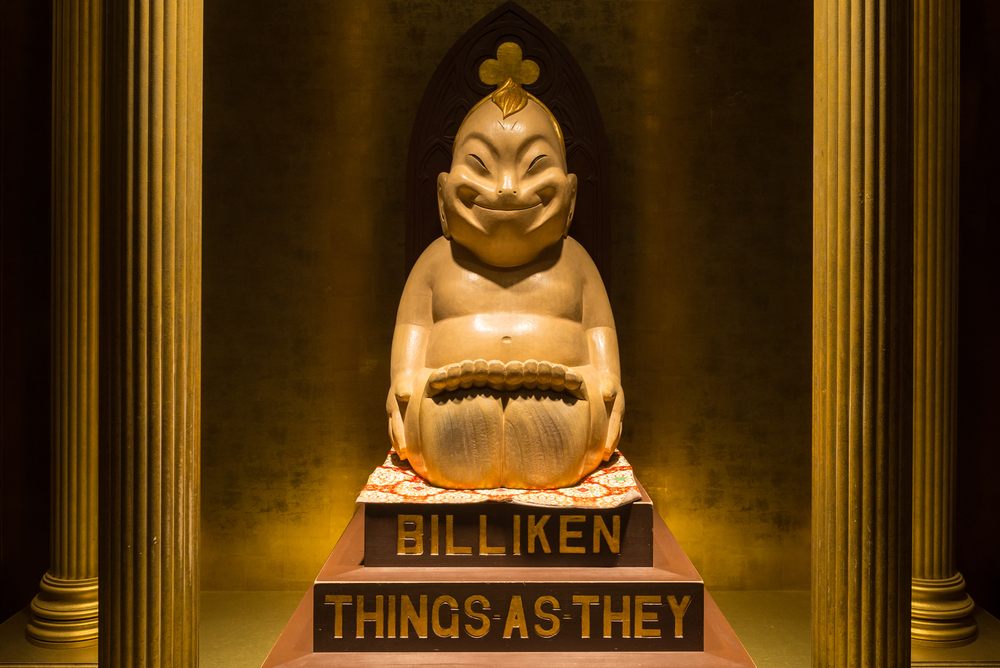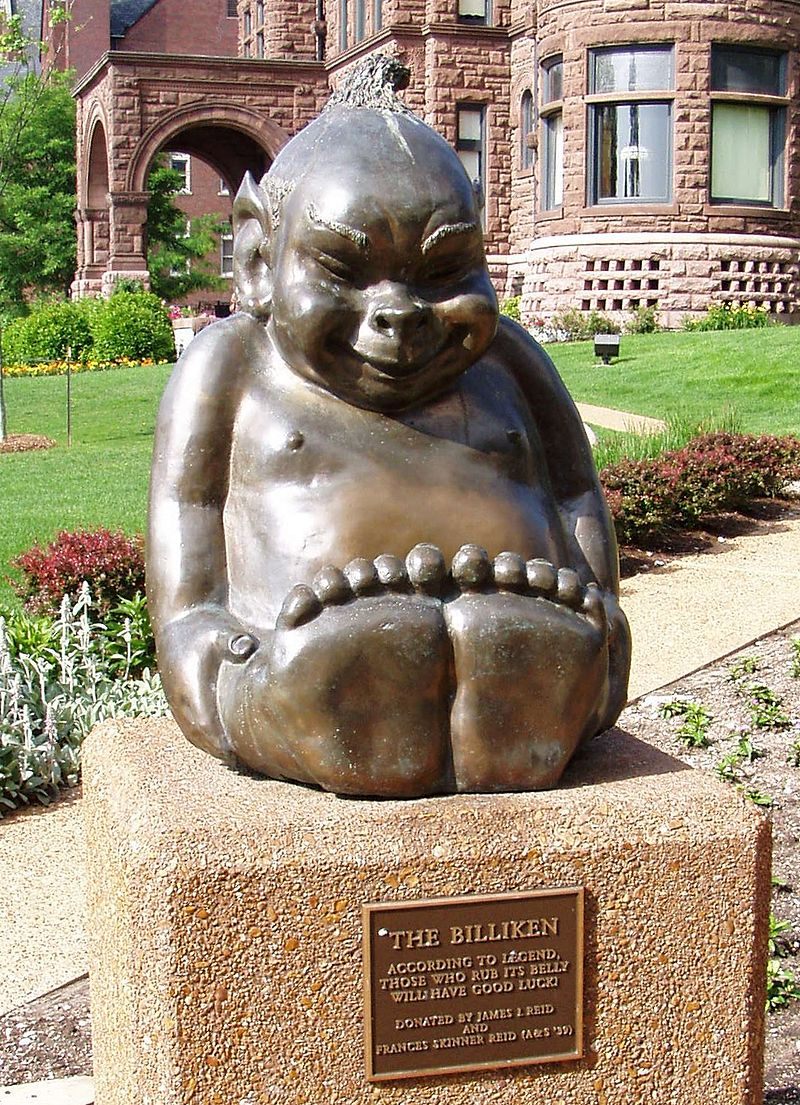The Billiken is Much More Than the Strangest College Mascot
The history of The God of Things As They Ought to Be, from tchotchke to college sports oddity.

A Billiken statue in Japan that just wants you to chill out. (Photo: twoKim/Shutterstock.com/Used with Permission)
Go Tigers! Go Falcons! Go… uh… Billikens?
Most sports teams, college or otherwise, are associated with a team mascot that’s some mighty animal or burly stereotype. But St. Louis University’s athletics team is represented by something a fair bit stranger: a portly little goblin called a Billiken. As bizarre as the little munchkin figure is as a college mascot, it has a history that dates back to the early 20th century and incorporates President Taft, Japan, and one enterprising illustrator.
The Billiken was first brought into the world in 1908 by Kansas City teacher and illustrator Florence Pretz. The illustrator was living in a studio space she called “The Eggshell” with a pair of other creators when she took to drawing chubby little fairy figures that would eventually evolve into the Billiken. The proto-creatures first appeared in a series of short stories that ran in the Canadian periodical Canada West, where their lighthearted antics first caught the attention of the public.
The stories took their inspiration from the fantastical poems of Canadian poet Bliss Carman, of whom Pretz was a fan. In fact the name “Billiken” seems to have been borrowed straight from his poem Mr. Moon: A Song of the Little People, published in 1896. The name is mentioned among a roll call of fairy figures who are calling at the moon to come to Earth and play.

Billiken figures from 1909. (Photo: Joe Mabel/CC BY-SA 3.0)
Pretz originally drew Billikens as sprightly, fat baby nymphs in motion, with wings and long, pointed feet,. Later, she removed the wings and plumped up the figure. The top of the head was drawn up into a point, and the cherubic little figure was put in a sitting position, with the flats of its feet showing forward. Finally it was plastered with a mischievous little grin between its pointed ears.
The new figure resembled a sort of trickster Buddha, and the Asian influences that Pretz had incorporated were in full effect when the creature was revealed in the pages of the May 1908 Chicago Daily Tribune. The paper heralded the billiken as a “Good Luck God,” and featured images of Pretz in a kimono, lighting incense before a small Billiken statue. Later that year, she filed a patent on the figure. The popularity of the weird little cherub was already catching on.
Pretz sold her patented god design to the Billiken Company in Chicago, although it is unclear whether the company was named that previously. Regardless, they began to produce small chalkware figurines of the Billiken, eventually including a pedestal that named him “The God of Things As They Ought to Be.” The lore went that you could rub the figure’s belly, or the soles of its feet for good luck. According to one ad from a November 1908 paper, the Billiken “is more lucky than a rabbit’s foot in the hind pocket of the seventh son of a seventh son.”

A trio of Japanese Billikens. (Photo: Guilhem Vellut/CC BY 2.0)
The character was a hit, creating a fad that spread across the world. Billiken merchandise, authorized or not, began flooding the market. There were decorative plates, banks, dolls, and all manner of other tchotchkes. In Alaska, locals began carving stylized Billiken charms out of walrus ivory and elk horns. In Japan the figure fit right into the pantheon of good-luck gods that had inspired it in the first place.
Comparisons to President Taft, who had been elected in 1909 and was known for his equally rotund appearance, became common, with Billikens appearing that had been given the mustachioed face of “Bill” Taft. This also inspired the creation of Teddy-Billiken dolls, eerie looking toys with the goblin head of a Billiken, attached to a plush body. After the previous success of Roosevelt’s teddy bear, it was hoped that a Billiken could become a best-selling toy for the Taft generation. Unsurprisingly, the market for Teddy-Billiken dolls was short-lived.
By 1912, the Billiken mania that had exploded over just a couple of years died down just as quickly. The manufacture of Billiken products all but ceased, and the good luck figure all but disappeared from the American consciousness, like pogs and the Macarena. Well, except in St. Louis.

An ad for Saint Louis University. (Photo: Paul Sableman/CC BY 2.0)
The exact story of how the Billiken came to be the mascot of St. Louis University is a bit unclear, but it all has to do with former football coach John Bender. In 1910, Bender took over the St. Louis University football program, and the press took notice of his cherubic looks, which inspired him to be compared to a Billiken. Versions of the story say that Bender noticed an editorial illustration in a St. Louis drug store, or that someone in town gave it to him, but however it happened, the football team soon came to be known as “Bender’s Billikens.” Bender only coached the team for a single year, but the name stuck, and the Billiken became the mascot for all of the university’s athletic teams.
Over the decades, the St. Louis Billiken has been redesigned a number of times, and the mascot is now a far cry from the original God of Things As They Ought to Be. Like sports mascots, he is an energetic figure who runs around getting the crowd pumped up—nothing like the plump don’t-worry-be-happy figure that took the nation by storm in the early 20th century. However, the original Billiken is still remembered by a brass figure of the god that has been installed outside of the Chaifetz Arena at the school. The feet and belly have been rubbed to a sheen by people looking for a little luck, just as it ought to be.

The Billiken statue outside of Chaifetz Arena, just as it should be. (Photo: Wilson Delgado/Public Domain)











Follow us on Twitter to get the latest on the world's hidden wonders.
Like us on Facebook to get the latest on the world's hidden wonders.
Follow us on Twitter Like us on Facebook